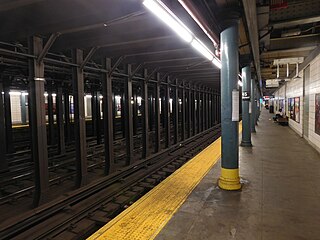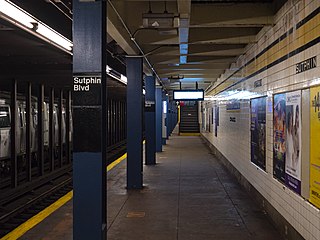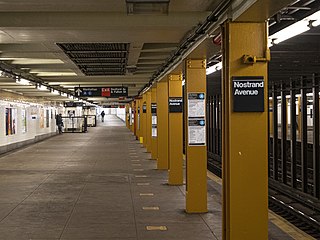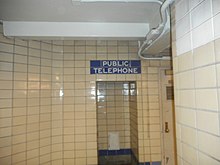
The Winthrop Street station is a station on the IRT Nostrand Avenue Line of the New York City Subway, located in Brooklyn at the intersection of Winthrop Street and Nostrand Avenue. The station is served by the 2 train at all times and the 5 train on weekdays.

The Howard Beach–JFK Airport station is a subway/people mover station complex located at Coleman Square between 159th Avenue and 103rd Street in Howard Beach, Queens. The New York City Subway portion of the station is on the IND Rockaway Line and is served by the Rockaway branch of the A train at all times, and the AirTrain JFK portion of the station complex is served by the AirTrain's Howard Beach branch at all times.

The 86th Street station is a station on the BMT Fourth Avenue Line of the New York City Subway, located at 86th Street and Fourth Avenue in Bay Ridge, Brooklyn. It is served by the R train at all times.

The 59th Street station is an express station on the BMT Fourth Avenue Line of the New York City Subway. Located at 59th Street and Fourth Avenue in Sunset Park, Brooklyn, it is served by the N and R trains at all times. During rush hours, several W trains also serve the station.

The 75th Avenue station is a local station on the IND Queens Boulevard Line of the New York City Subway. Located at the intersection of 75th Avenue and Queens Boulevard in Forest Hills, Queens, it is served by the F train at all times, the E train at all times except weekday rush hours and middays, and the <F> train during rush hours in the reverse peak direction.

The Church Avenue station is an express station on the IND Culver Line of the New York City Subway. Located at Church and McDonald Avenues in Kensington, Brooklyn, it is served by the F and G trains at all times, and by the <F> train during rush hours in the peak direction.

The Bay Ridge Avenue station is a station on the BMT Fourth Avenue Line of the New York City Subway, located at the intersection of Bay Ridge Avenue and Fourth Avenue in Bay Ridge, Brooklyn. It is served by the R train at all times.

The 45th Street station is a local station on the BMT Fourth Avenue Line of the New York City Subway. Located at 45th Street and Fourth Avenue in Sunset Park, Brooklyn, it is served by the R train at all times. The N train also stops here during late nights, and some rush-hour W trains stop here in the peak direction.

The 77th Street station is a station on the BMT Fourth Avenue Line of the New York City Subway. Located at 77th Street and Fourth Avenue in Bay Ridge, Brooklyn, it is served by the R train at all times.

The 53rd Street station is a local station on the BMT Fourth Avenue Line of the New York City Subway. Located at 53rd Street and Fourth Avenue in Sunset Park, Brooklyn, it is served by the R train at all times. The N train also stops here during late nights, and some rush-hour W trains stop here in the peak direction.

The Parsons Boulevard station is an express station on the IND Queens Boulevard Line of the New York City Subway. Located at the intersection of Parsons Boulevard and Hillside Avenue in Queens, it is served by the F train at all times, the <F> train during rush hours in the reverse peak direction, and a few rush-hour E trains.

The 169th Street station is a local station on the IND Queens Boulevard Line of the New York City Subway. Located at the intersection of 169th Street and Hillside Avenue in Queens, it is served by the F train at all times, the <F> train during rush hours in the reverse peak direction, and a few rush-hour E trains to Jamaica–179th Street during p.m. rush hours.

The Sutphin Boulevard station is a local station on the IND Queens Boulevard Line of the New York City Subway. Located at Sutphin Boulevard and Hillside Avenue in Jamaica, Queens, it is served by the F train at all times, the <F> train during rush hours in the reverse peak direction, and a few rush-hour E trains to Jamaica–179th Street during p.m. rush hours.

The High Street station, also signed as High Street–Brooklyn Bridge, and also referred to as Brooklyn Bridge Plaza and Cranberry Street, is a station on the IND Eighth Avenue Line of the New York City Subway. It is located at Cadman Plaza East near Red Cross Place and the Brooklyn Bridge approach in Brooklyn Heights, Brooklyn. Its name comes from older street names; its original location was at the intersection of High Street and Washington Street. It is served by the A train at all times and the C train at all times except late nights.

The Van Siclen Avenue station is a local station on the IND Fulton Street Line of the New York City Subway. Located at the intersection of Van Siclen and Pitkin Avenues in the East New York neighborhood of Brooklyn, it is served by the C train at all times except nights, when the A train takes over service.

The 111th Street station is a station on the IND Fulton Street Line of the New York City Subway, located on Liberty Avenue at 111th Street in Richmond Hill, Queens. The station is served by the A train at all times.

The Nostrand Avenue station is a bi-level express station on the IND Fulton Street Line of the New York City Subway, located at the intersection of Nostrand Avenue and Fulton Street in Bedford–Stuyvesant, Brooklyn. It is served by the A train at all times and the C train at all times except late nights.

The Grand Avenue–Newtown station is a local station on the IND Queens Boulevard Line of the New York City Subway. Located under private property at the northeast corner of the intersection of Grand Avenue, Broadway, and Queens Boulevard in the neighborhood of Elmhurst, Queens, it is served by the M train on weekdays, the R train at all times except nights, and the E and F trains at night.

The Fourth Avenue/Ninth Street station is a New York City Subway station complex shared by the elevated IND Culver Line and the underground BMT Fourth Avenue Line. It is located at the intersection of Ninth Street and Fourth Avenue in Park Slope, Brooklyn and served by the:

The Jay Street–MetroTech station is a New York City Subway station complex on the IND Fulton Street, IND Culver, and BMT Fourth Avenue lines. The complex is located in the vicinity of MetroTech Center in Downtown Brooklyn. It is served by the A, F, and R trains at all times; the C train at all times except late nights; the N train during late nights only; and a few rush-hour W and <F> trains in the peak direction.



























